Wild About Gwent
SPRING/SUMMER 2024

PINE MARTENS Back in Gwent
WE’VE MOVED To a new HQ!
SAVE THE GWENT LEVELS
Thousands support campaign at the Senedd MEMBERSHIP SURVEY
We want your views


PINE MARTENS Back in Gwent
WE’VE MOVED To a new HQ!
SAVE THE GWENT LEVELS
Thousands support campaign at the Senedd MEMBERSHIP SURVEY
We want your views
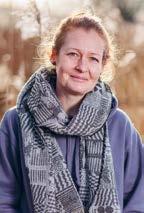
Spring is at last afoot as I write this in April - although the rain continues and I feel like the endless sunshine that I remember (as the first COVID lockdown struck us all) four years ago was a dream.

This time of year, I am drawn to enjoy the outdoors as much as possible, so I confess it has pained me a little to accept the role of Interim CEO, with Adam Taylor having moved on and recruitment beginning in earnest for GWT’s next CEO.
My slight reticence is simply as I find spring and summer the most exciting seasons of the year, as our wildlife emerges from its slumber and our nature reserves begin to look their glorious selves. This interim role, while a welcome challenge, also inevitably involves more indoor meetings and time behind a computer than required of my usual role leading the nature recovery team.
So, I say to those of you able to get outside over the coming months, make sure you don’t miss the splendour of bluebells at Prisk Wood and Silent Valley, the green winged orchids and cowslips at Pentwyn Farm and New Grove Meadows and all the wildlife to be discovered at our newly opened Bridewell Common.
While I can’t enjoy it all to the full at the moment, I urge you to make the most of nature’s splendid show as many of us beaver away behind the scenes! I’m not really complaining at all, I’ve enjoyed Gwent’s glory for the past 22 years I’ve been working at the Trust. I know there’s much we can achieve across Gwent to help nature’s recovery and I’m honoured to lead our brilliant staff team whilst we work towards this.
Gemma Bodé, GWT Interim CEO
Dyn ni’n dysgu Cymraeg!
Thirteen of the GWT staff team are enjoying learning Welsh with Josh Wheeler from Coleg Gwent. We’re halfway through the introductory course Mynediad 1 and already proud to be able to have simple conversations in Welsh.

Gwent Wildlife Trust Editorial Team & Contributors
Sarah Harris (Editor) Kath Beasley, Gemma Bodé, Hamish Blair, Rose O’Hagan, Andy Karran, Nathalie Nicolaus, Debbie Stenner Guest Contributors / Thanks to
Simon Bazeley, Krystal King, Nerys Lloyd-Pierce, Mark Mogford, Ian Rabjohns, Wildlife Warrior Aiden and Nature Nurturer Abigail
GWENT WILDLIFE TRUST, Chestnut Suite, Mamhilad House – Block A, Mamhilad Park Estate, Pontypool, NP4 0HZ Tel: 01600 740600 Email: info@gwentwildlife.org Web: www.gwentwildlife.org Reg Charity No: 242619 Limited Liability Company No: 812535.
Above, Hundreds joined us at the Senedd for a peaceful demonstration ahead of our petition hearing. Below, our cover image is Pine Marten by Mark Hamblin 2020 Vision.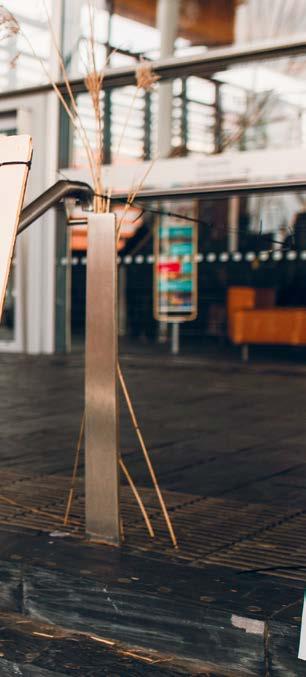
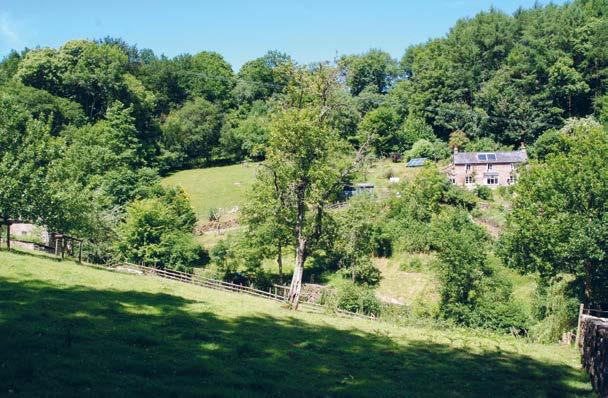
10
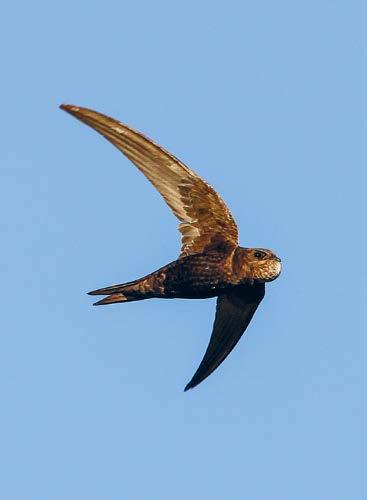
21
2
JOIN TEAM WILDER AT GWT!
To find out more about the work of GWT, become a member/volunteer, get involved in our events, read our latest blogs, and visit our website to see other updates. www.gwentwildlife.org
GET IN TOUCH WITH US:
Call us: 01600 740600
Email us: info@gwentwildlife.org
Facebook: @gwentwildlife
Twitter: @GwentWildlife
Instagram: @gwentwildlifetrust
YouTube: Gwent Wildlife Trust
GET ALL THE LATEST GWT NEWS
You can receive our monthly updates on all things wild and wonderful in Gwent by signing-up to our enewsletter: www.gwentwildlife.org

PRIVACY POLICY: In line with General Data Protection Regulation we outline why we capture your personal data, what we use it for, and how we keep it safe, please visit our website gwentwildlife.org/ privacy-policy or call us on 01600 740600.
SAVE THE GWENT LEVELS AGAIN We take our petition to the Senedd
4
TRUST NEWS
New starters and our new HQ
5
SNAPSHOT SPOTLIGHT
A round-up of how Wild Health sessions have been making a difference for people and nature
6-7
FILTERING THE FACTS FROM FICTION
How citizen science is helping Gwent Rivers
8-9
ACTIONS FOR WILDLIFE Volunteering showcase
10
RURAL WILDLIFE RETREAT Report from a Local Wildlife Site
11-14
TELL US WHAT YOU THINK Please take part in our membership survey
16
NIGHTJAR AND ADDER
Discover more about these wonderful elusive creatures
18
STAND FOR NATURE WALES
Young people share their passion for taking wildlife action
21
SWIFT INTERVENTION
Mark Mogford explains how his group is helping this endangered bird
22
PINE MARTENS A project update
25
WILDLIFE CHAMPION
Meet Ian Rabjohns who has spent decades restoring and protecting wildlife at his rural idyll
DIARY MARKERS
Find all our spring and summer events listed on the back page
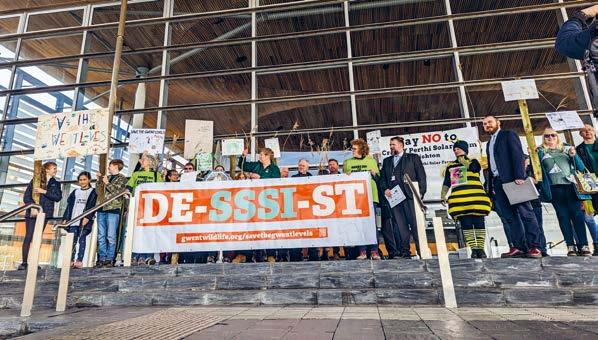
As you will remember from the last edition of Wild about Gwent, we launched an urgent campaign to protect the Gwent Levels once again, as threats from inappropriate development such as business parks, industrial estates and huge solar power stations loom over our irreplaceable landscape.
Our petition, halt significant new development on the Gwent Levels SSSI, gained thousands of signatures (over 6k) thanks to our members, concerned communities, and the support of
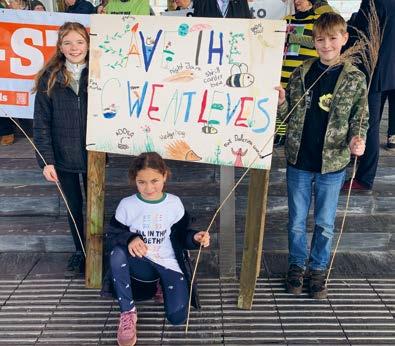
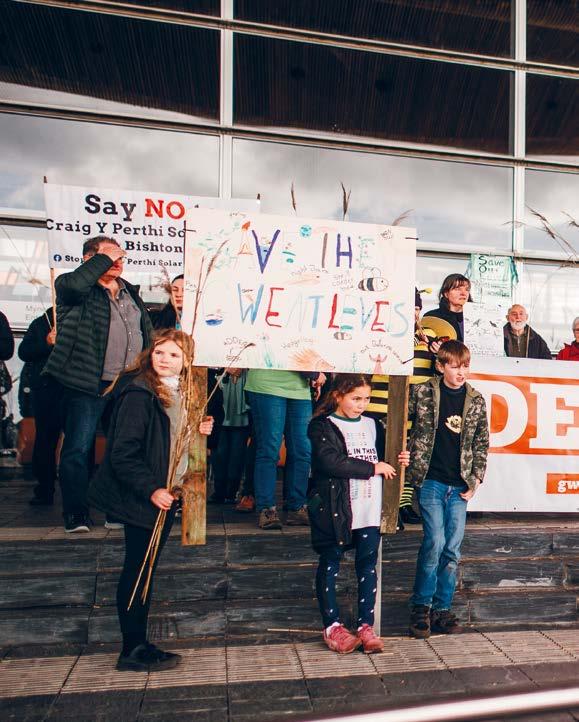
naturalists and authors such as Iolo Williams, Gillian Burke, Mary Colwell, Lizzie Daly, and Julian Hoffman.
On March 18, the Petitions Committee debated our petition, and addressed our pressing demands. That:
• Welsh Government release the study results of post-construction monitoring of developments on and near the Gwent Levels SSSI
• Welsh Government release guidance on how to interpret the new Chapter 6 of Planning Policy Wales, clarifying the ‘wholly exceptional circumstances’ and ‘site selection tests’ elements.
• Petitions Committee insist on a ‘short inquiry’ on our petition request: Halt significant new development on the Gwent Levels SSSI
In order to drive our message home, we organised a hugely successful demo on the steps of the Senedd in Cardiff Bay. More than 100 people voiced their support for protecting the Gwent Levels.
Our supporters included GWT members, Levels farmers and residents, community groups, young Wildlife Warriors, Friends of the Gwent Levels (FOGL), and opponents of the huge Craig-y-Perthi solar power station
that will engulf the village and oust neighbouring tenant farmers.
In an impassioned address to the assembled crowd, our Planning Manager, Mike Webb, explained the vital importance of giving the Gwent Levels formal protection, saying,
“Some politicians don’t appear to understand the value of the Gwent Levels, and think that this is where they can dump all their bad neighbour developments. They do not understand either, how passionately we care about this landscape, and the wonders contained within it. We need to protect it for our future, as I do not want Welsh children to grow up in a landscape covered in a sea of glass, and tarmac and concrete, with no lapwings, bees, wildflower meadows or skylarks to bring joy and wellbeing. We will not be going away, this is a landscape worth fighting for, and we will continue to do so.”
Third generation Levels resident and farmer, Ceri Hoffrock, opponent of the massive Craig-y-Perthi solar power station, had this to say,
“This colossal development will engulf thousands of acres, destroying our community, and the stunning landscape around us. And this is not the only huge power station proposal. If all these developments go ahead, the heart will be

ripped out of the Gwent Levels SSSI, along with the nature that depends on it, and the livelihood of farmers who have worked here for generations. The harm will be catastrophic.”
Here at Gwent Wildlife Trust, we are continuing the fight to protect the wonderful Levels landscape and the teeming wildlife that depends upon it. Look at our website and social media to find out how things progress. In the meantime, if you can write to your local councillors and MSs to let them know how passionately you feel about protecting this irreplaceable landscape, then that will help hugely.


Nerys Lloyd-Pierce has been working with Gwent Wildlife Trust on our Save the Gwent Levels Campaign, providing fantastic PR and media support to help raise the campaign profile and drive support for the petition. Diolch yn fawr iawn Nerys: http:// www.lloyd-pierce.co.uk/
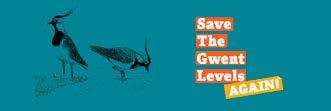
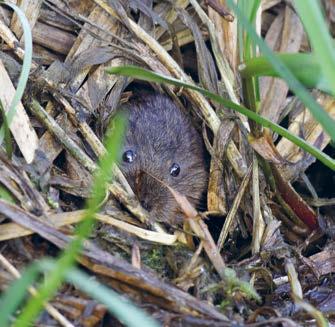
We have been successful with third round Nature Networks Fund (NNF3) grant application via Welsh Government, through the Future Resilience for Natural Assets - a grant administered via the National Lottery Heritage Fund.
The funding of £250,000 over two years will greatly support our Nature Reserves biodiversity works, helping us to improve infrastructure including replacement fencing, gates and stock grazing provision and purchase new kit, all assisting us to manage our reserves more efficiently for better outcomes for wildlife.
We are also delighted to announce that a second NNF3 application we made, for Feasibility into Water Vole Reintroduction on the Wentlooge Levels has also been successful!
This funding of £106,000 will allow us to employ an additional member of staff for 18 months to explore the possibility of bringing back water voles on the Wentlooge side of the Gwent Levels. This exciting project will involve us working with local landowners and other partnership organisations to support our aspirations for this endangered species, which we previously successfully reintroduced on the eastern side of the Levels at Magor Marsh nature reserve.
We will keep you up to date with these projects via our enewsletter, social media and in this magazine.


March, this year, was an exceptional month of change at Gwent Wildlife Trust.
Our CEO, Adam Taylor has moved on to new ventures after 16 years within the Wildlife Trust movement, with the past four and half years at GWT. During his tenure, among other achievements, Adam spearheaded the renewal of our 2030 strategy and led the implementation of greatly improved working policies and procedures across HR, Health and Safety and many other areas of our operations.
Our board of trustees have appointed Head of Nature Recovery, Gemma Bodé as interim CEO whilst recruitment is underway.
Chair of Trustees Marc Leppard said: “I know that everyone joins us in wishing Adam well for the future and will support Gemma in her new role.”
In other news, we said a fond farewell to our Communications Coordinator Emily MacAulay as her project concluded, and Mike Webb, who has retired from his role as Planning Manager. We continue to benefit from Mike’s passion and expertise however, through his ongoing involvement
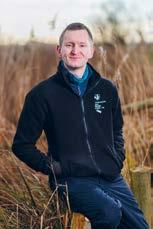
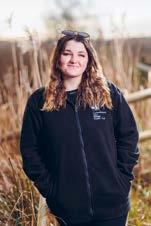
with campaigning to protect the Gwent Levels. Meanwhile, we appointed Thomas Campbell as our new Nature Recovery Manager and welcomed back Alice Rees as our new Fundraising Manager. We also appointed 6 new trustees to our Board. You can read short bios of all our staff and trustees on our website: www.
gwentwildlife.org/about-us2/our-people
Earlier in March, we moved our head office from Seddon House in Dingestow to Mamhilad Park Estate near Pontypool. A huge thank you to the Bosanquets for having us at Dingestow Court and being so accommodating over the years. We still have satellite offices in Pentwyn, Ebbw Vale and Magor Marsh and apart from a change of address, our phone number and other contact details remain the same. See page 1 for all our contact details.
Programme Manager Liz Stokes project-managed our HQ move. “Our former offices in Monmouthshire served us well but as our work evolves and our team grows we needed a new head office that could offer more space, flexible terms and a connected, central location to help us on our mission to protect Gwent’s wildlife and our natural environment.
“Mamhilad really is a great location for us to scale-up and deliver on our strategic objectives, including to work with more businesses to help them to deliver green goals and provide solutions to climate change and biodiversity loss. Located in the centre of Gwent, our new HQ is situated on a thriving business park that is also easily accessible for our team to service all of our nature reserves in the area.”
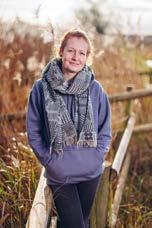
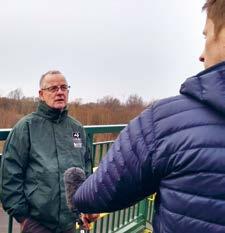

Has spending time in nature helped you feel better? If so, please join our GP Postcard Campaign and send a free postcard to your GP to spread the positive news!
Evidence shows the incredible power nature has to soothe us, motivate us and restore our mental wellbeing. But most of us are unlikely to let our doctors and other health professionals know when we feel well, so The Wildlife Trust’s new campaign tool can help you do exactly that.
You can use our new postcard action to send a message to your GP or other health professional – tell them how nature is helping you!
Perhaps you’ve joined a volunteer group and it’s made you feel less isolated. Or maybe you’ve spent time walking in your local nature reserve to increase your fitness levels.
We hope that the more people that share their stories about their experiences, the more that spending time in nature will be formally encouraged to others to improve their wellbeing. There’s an extra bonus too - healthier, happier people means less pressure on our NHS.
You can send your card now –they’re free but there’s also an option to pay it forward, where you can donate the cost of your own card plus up to 5 more, allowing others to share their stories too: www.wildlifetrusts. org/nature-helps
Check out our campaign and send your card today! #NatureHelps https://www.wildlifetrusts.org/ nature-health-and-wild-wellbeing
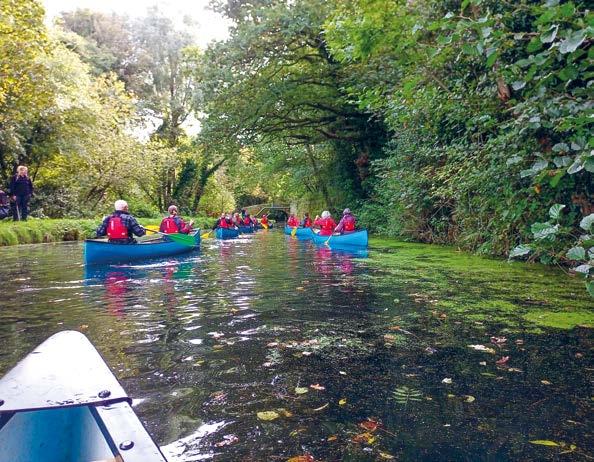
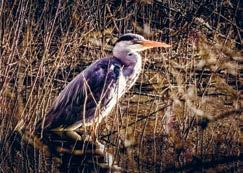
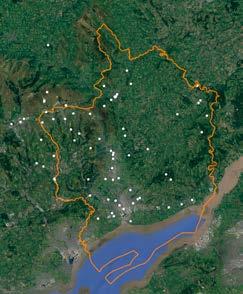
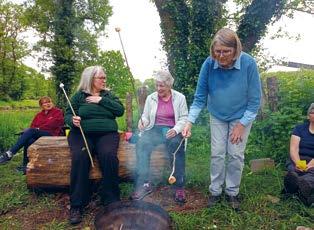
Above, 2023 saw the start of open-access, 6-week bushcraft courses for women, followed by monthly drop-in sessions for the duration of the funded project. Above right, Wild Health participant Simon Bazeley has shared some of his fantastic photography skills on our Gwent Wildlife Spotting Facebook Page. Right, Learning New Skills! Particpants from the Romani Culture and Arts Company and Elysium Healthcare made these beautiful stools.
The Wild Health team has been very busy over the last year improving people’s health and wellbeing across Gwent. Throughout 2023, we engaged with a staggering 664 people, at 70 different locations, delivering hundreds of hours of nature-based well-being activities to get people outdoors and inspired to act for nature! Here are just a handful of examples.
One occupational therapist told us that attending Wild Health was “the turning point” for one of her patients, saying: “Before (his involvement with) Gwent Wildlife’s Wild Health he refused to take part in any other groups and was too scared to get out of the vehicles. Coming to the Wild Health sessions helped him get over his fear of uneven ground and then he started to attend other activities in the community. It really helped him turn his life around.”

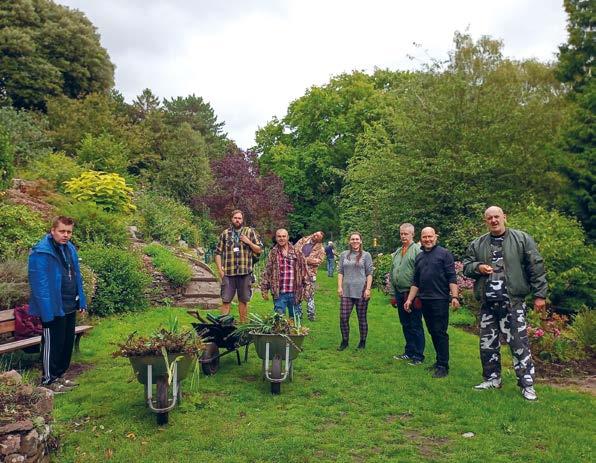



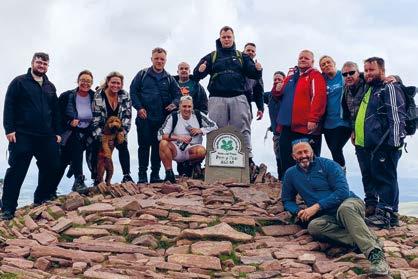

We are gathering water quality data for the River Usk. By GWT’s River Restoration Officer Nathalie Nicolaus.
In October last year, Gwent Wildlife Trust joined the ‘CaSTCo’ project: a program to monitor water quality in the River Usk catchment, a project managed by the Wye and Usk Foundation (WUF). Despite its designation as a Special Area of Conservation (SAC), the River Usk is in ecological decline. Its habitat features are unfavourable for the majority of protected species, including Atlantic Salmon, Shad, Lamprey, Bullhead, and Water Crowfoot. Water pollution and other water quality stressors are one of the key drivers of biodiversity loss in the catchment.
Catchment Systems Thinking Cooperative (CaSTCo) is a partnership project in eight demonstration river catchments in England and Wales. The work is funded by the Water Services Regulation Authority Ofwat and led by United Utilities and the Rivers Trusts in collaboration with local water companies, academia, and environmental charities. The project intends to transform the way environmental data about our river

catchments is collected, managed and shared. The River Usk catchment is the only demonstration catchment in Wales, which has allowed Gwent Wildlife Trust (GWT) to become one of the project partners.
Citizen Science is one of the key elements of the project, to produce the much-needed local evidence base to better understand our river and tackle the environmental challenges we are facing.
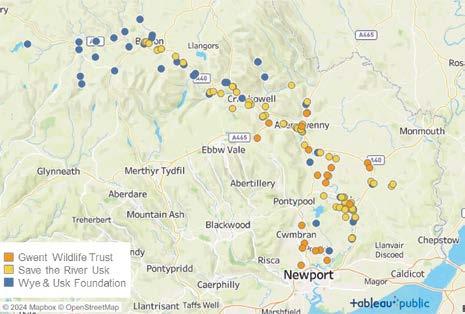
Across the catchment, three citizen science groups are actively contributing to fill the project database; volunteers from the Wye and Usk Foundation; the community group, Save the River Usk, who have been gathering data in the catchment independently for almost two years; as well as our own GWT group of citizen scientists. The GWT group gathers data specifically for the Usk waterways in Gwent. This includes


the main River Usk downstream of Abergavenny, the Afon Lwyd, the River Clydach, and smaller tributary streams.
To date, GWT have trained 29 citizen scientists who monitor 25 allocated sampling locations every week. All citizen scientists on the project measure the same set of water quality parameters with approved standardised equipment. The parameters include phosphates, nitrates, ammonia, electrical conductivity, and water temperature. We are also measuring water clarity or turbidity, a measure of suspended particles in the water such as soil. But that is not all, our volunteers also make observations of conservation features and site conditions. This includes the monitoring of riverbank erosion, the presence of algal blooms, and sightings of key animal and plant species, such as Otter, Dipper, or Water Crowfoot. The recording of nonnative invasive species such as Himalayan Balsam, Japanese Knotweed and Giant Hogweed is also part of the weekly survey.


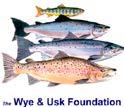
‘Without the free time and effort provided by citizen scientists, the labour costs of a monitoring programme of this scope and scale would be prohibitive’
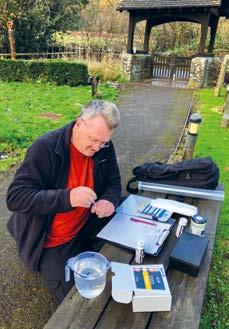
Susan Brown was one of the first citizen scientists who joined the GWT group last year. She monitors the Afon Lwyd, a tributary that flows into the Usk at Caerleon. Susan said, “Without the free time and effort provided by citizen scientists, the labour costs of a monitoring programme of this scope and scale would be prohibitive, so –especially as I transition into retirement – it feels good to belong to a team that enables such an important project to proceed. Also, I do enjoy using the ‘grown-up’ version of a child’s chemistry set!”
Once the survey is completed at the site the data is uploaded via an app to the project database. The data from all three groups is collated, quality checked, and made publicly available on the UskViz tableau https://public.tableau.com/app/ profile/wyeusk/viz/UskViz/START, a visualisation platform that analyses the data collected across the River Usk catchment. Over time the platform will become a powerful tool to understand trends, spot anomalies, and provide insights into the pressures and challenges our river
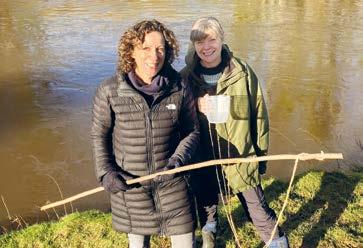
is facing. Not just for the project team or our citizen scientists, but for the authorities and all parties involved with improving the health of the river.
Data collection is planned to run until Spring 2025, followed by in-depth data analysis and report write-up. Over the course of the year, we are planning to bring all citizen scientist groups together to learn from each other and share experiences.
Saturday 1 June 2024 (10am - 3pm)
Join us at the first River Usk Festival and learn more about the project and the work we do: a celebration of the River Usk and the communities that live and work alongside this beautiful river. For more details please visit www.gwentwildlife.org/events/202406-01-river-usk-festival or email together@savetheriverusk.org.
Thank you to all our volunteers, partners and supporters! Here are just some of the ways you’ve been helping nature recover so far this year.
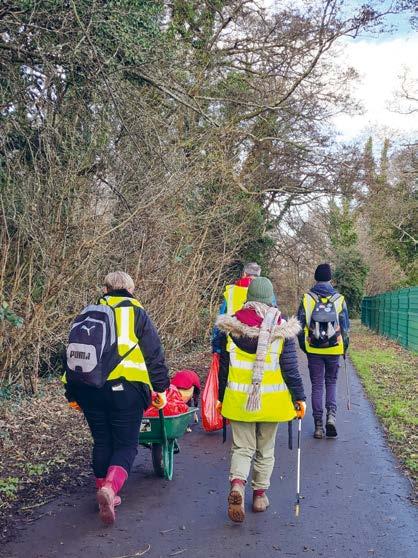
At the start of 2024, the Stand for Nature Wales Gwent Group, in conjunction with the other four Stand For Nature Wales groups in Wales, ran Plast Off! – an annual litter pick.
Held along a stretch of the Afon Lwyd in Cwmbran on a dry, cold morning, people were keen to start the new year with gusto! A total of 20 people attended, 9 young people from Stand For Nature Wales, 6 members of the public and 4 staff and volunteers.
Together we filled an incredible 16 litter bags, found various other items such as scooters, wood, a gate, clothes and illegal laughing gas canisters. They also returned two trolleys to Morrisons supermarket!
One volunteer told us that he had a great morning collecting all that litter and it made him feel really good. The young people in the group commented several times that they really couldn’t understand why people would throw down all this rubbish spoiling a beautiful area.


Our Community Ecologist Kath Beasley and volunteers made an amazing discovery at Magor Marsh during half term.
Kath said: “Our Harvest mouse survey training day at Magor Marsh was fully booked with volunteers (including four young people from our Stand for Nature Wales group) and we discovered the first record of Harvest mice at the reserve since 2014!
“We found a total of five Harvest mice nests (two breeding, three solitary) alongside lots of field/bank vole and a couple of water vole nests! The young people were exceptionally good at spotting and the sun even joined us! A big thanks to our Youth Engagement Officer Petra Mitchard and Senior Evidence Officer Lowri Watkins for helping on the day.”
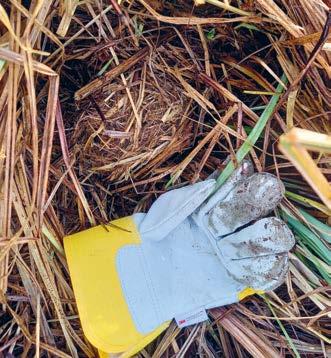
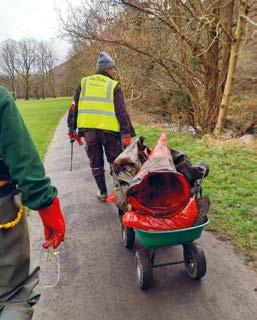
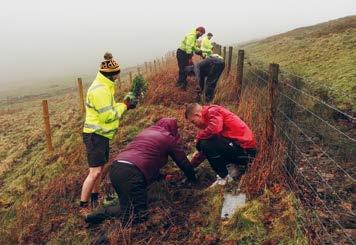
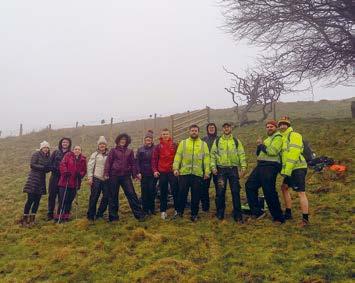
In March, Kath Beasley and Liz Winstanley ran a team-building day for Blackwood Engineering. Eighteen members of staff joined us into the depths of Silent Valley nature reserve to assist in some tree planting on a very wet and windy day. Despite the pretty rubbish weather at the top of the reserve, spirits remained high and together we planted 450 saplings! We’re hoping these saplings will develop into a species-rich hedge, creating food and shelter for wildlife as well as reducing water run off from the hillside. Blackwood Engineering thoroughly enjoyed the day (or so they reassured us!) and have kindly donated £500 to our Big Give Green Match Fund appeal, which matched their gift to make it £1,000 for our river restoration work.

We ran a successful river clean up along the Ebbw Fach in Abertillery Park in March, as part of the Keep Wales Tidy ‘Spring Clean Cymru’ 2024 campaign.
Our Senior River Restoration Officer Nathalie Nicolaus said: “We counted around 30 bags of litter as well as several metal pieces, pipes, a cement mixer! and a shopping trolley. Organisations and partners included KWT, South East Wales Rivers Trust, NRW, Blackwood Litter Group and GWT volunteers. Thanks to our Community Ecologist Kath Beasley for her support.”
Future river clean-ups in Gwent are planned for the summer and anyone wishing to get involved should contact Nathalie Nicolaus nnicolaus@gwentwildlife.org
Support from the Sustainable Development Fund (SDF) a Welsh Government Initiative in the Wye Valley National Landscape was put to good use this spring as outlined by our Senior Conservation Officer Joe Ryder:
“As part of the Restoring The Wern SDF project we held two dry stone walling courses with ten willing volunteers.
Mark Dearman was our instructor over the two days at The Wern near Monmouth. Mark has been working on dry stone walls
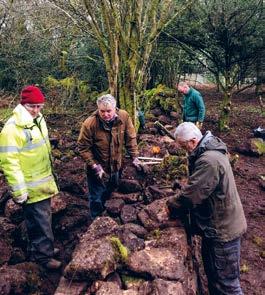

in the Wye Valley area for the past 30 years and he managed to show us the basic skills in just two days!. With this training our GWT volunteers can now go on and repair dry stone walls on our reserves. In one day alone we managed to get around 15m restored!
Dry stone walls are fantastic habitats with a labyrinth of dry, warm spaces within them for a range of species while providing a habitat for many species of moss and lichen.”
In March, we teamed up with the Severn Area Rescue Association (SARA) to aid the River Wye. Our Nature Recovery Officer Ben Boylett explained how: “Once again, SARA kindly assisted us at Piercefield Woodland nature reserve, retrieving tipped waste from this otherwise beautiful reserve.
“During a rope rigging rescue exercise yesterday, from the Alcove cliff viewpoint, the team managed to also retrieve a collection of waste as well as their training dummy casualty. We are very fortunate to have this partnership with SARA as retrieving the waste both from the cliff rigging as well as previous boating exercises on the Wye would be impossible without their specialist help. Thanks to our reserve warden Harvey Lloyd-Thomas for the photos.”
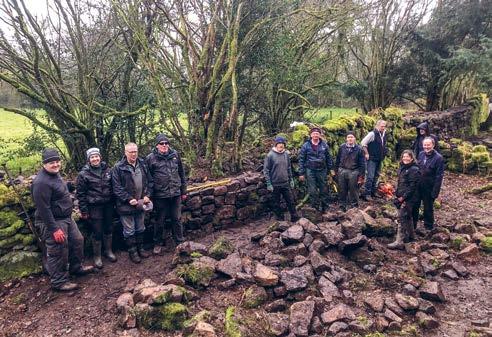

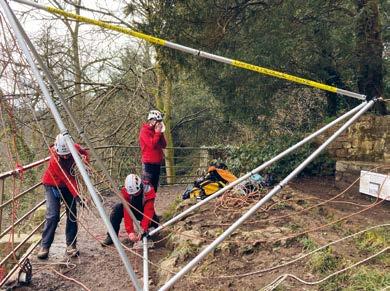
Our nature recovery volunteers will be benefitting from training in practical land management and some new tech for monitoring wildlife thanks to an ‘Awards for All’ grant from the National Lottery Community Fund. We’re so grateful for the support of players, which will enable more people to help with regular activity on our nature reserves - including recording wildlife species, managing invasive plants and keeping paths accessible.

If you’d like to find out more about becoming a GWT volunteer and future opportunities for volunteering and supporting our projects please contact our Volunteer Officer Sarah Coleman scoleman@gwentwildlfie.org or visit https://www.gwentwildlife.org/ get-involved/volunteer


Deep in the Wye Valley there is the most idyllic spot, a little patch carved out of the ancient woodland and heathland fragments which people have managed for centuries. There, an old stone cottage sits, surrounded by moss and lichen-covered dry stone walls, with beautiful hay meadows and mature orchard trees scattered throughout and the Black Brook running through. It always seems that when you visit the sun is shining, trapped in this little oasis of calm.
Mill Bank lies within the Trellech ridge that runs south from the Troy Park Estate to Devauden. Once known historically as Wyeswood Common, which is the name Gwent Wildlife Trust (GWT) took for the area of land we purchased back in 2008, lying adjacent to Pentwyn Farm in Penallt, to the south west of this site. Fragments of this once extensively wooded area are still evident across the landscape in the form of ancient pollarded trees such lime and alder. Mill Bank was designated as a Local Wildlife Site (LWS) in 2005 by GWT for its botanical interest. It lies within the Wye Valley National Landscape and is surrounded by several nationally designated sites within the Wye Valley.
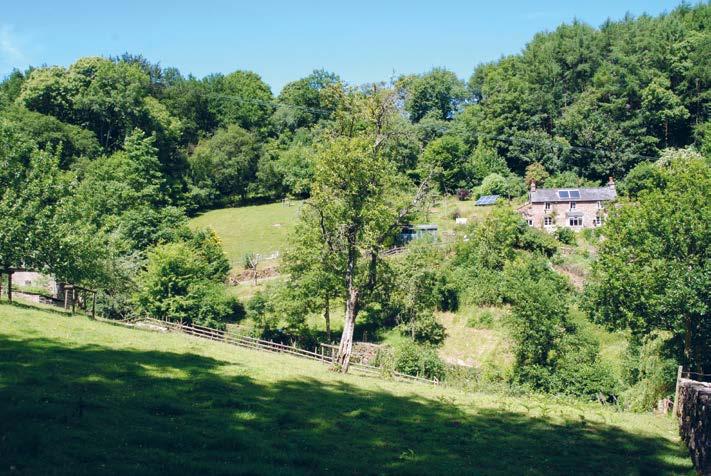

management by people that has created much of the invertebrate interest at Mill Bank.

Documents from AD 1295 are the first written records concerning the land near to Mill Bank with a water mill recorded in AD 1433 and the miller the first known resident, although archeological evidence suggests early post-medieval human activity in the area.
interceptive vane trapping since 1998, and amounts to over 39,685 individual insect observations! Ninety species of insect, generally regarded as scarce in Wales have been recorded, including the Rugged Oil Beetle Meloe rugosus, first described new to Wales from Mill Bank in 2007. There is even evidence to show that the Noble Chafer beetle (Gnorimus nobilis) has been present. The site holds 58% of the recorded vice-county macromoth species, 119 species of Hymenoptera (bees, wasps and ants) and 12 species of ants recorded alone. Species that “mere mortal” amateur insect observers might recognise include the Brown Hairstreak butterfly (Thecla betulae), the Necklace Ground Beetle (Carabus monilis) and the Bee Wolf (Philanthus triangulum).
The current landowner is Ian Rabjohns who has been managing the land for over 25 years, maintaining its traditional aspects of management through extensive grazing, orcharding systems and hay meadow management. This sensitive management backed up by years of study and data collection have confirmed that populations of nationally important invertebrates have thrived here, intimately connected with this sensitive land management. Multiple niches across the site provide opportunities for numerous types of insects and it is the impact of historical long-term
Mill Bank has been subjected to extensive survey over the years by the owner, Ian and his late wife Jessica, and since 2010, invertebrate specialist Paul Whitehead has been assisting. Data has been collated through active searching, Mercury Vapour light trapping and
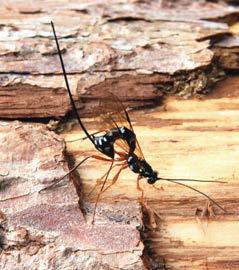

Paul’s increasing interest in the site over the years and realisation of its national and now international importance for invertebrates has with Ian’s support led him to write a fascinating account of the fauna recorded: “The invertebrate fauna of Mill Bank, Penallt, Monmouthshire, Wales: a traditionally managed biological hotspot in the Wye Valley” that can now be found on our website www.gwentwildlife. org. The study is a real homage to the commitment of Ian for his ongoing determination to manage the site so sensitively for nature conservation. Mill Bank’s owner Ian Rabjohns is our Wildlife Champion featured on page 25 of this magazine, read more about him there.
Tell us what you think for your chance to win a £50 garden centre voucher!
Your views and opinions are precious to us! We want to make sure we’re communicating with you in the right way for you, that what we talk about reflects your interests and you’re happy with how we treat you as a member.
Every valid submission gets entered into a prize draw to win a £50 National Garden Gift Voucher for use at your local garden
1. How long have you been a member? (If you’re not sure, please give us your best guess!)
Less than one year
More than a year, less than 3 years
More than 3 years, less than 6 years
More than 6 years, less than 15 years
More than 15 years
2. How satisfied are you, overall, with your membership?
Very satisfied
Satisfied
Neither satisfied or dissatisfied
Somewhat unsatisfied
Dissatisfied
Comments
3. Are you interested or involved in any of these activities with Gwent Wildlife Trust?
Volunteering on a Nature Reserve/outdoors
Volunteering in the office
Joining a Local Group
Taking part in events, groups or courses
Fundraising for us with an event
Taking part in a sponsored challenge
Taking part in a campaign (e.g. by writing to your AM, MP or signing a petition)
Getting involved with my employer or a group I belong to
Wildlife surveys e.g. bioblitz, monitoring
centre. More information about the voucher is available here: https:// nationalgardengiftvoucher.co.uk
If you can, please complete the survey online (as this is much easier for us to administer) by visiting: gwentwildlife.org/ survey. Or cut out and complete this printed copy of the survey and post it to: Chestnut Suite, Mamhilad House – Block A, Mamhilad Park Estate, Pontypool, NP4 0HZ

4. Which of these statements best describes why you support Gwent Wildlife Trust as a member?
Please rank 1 – 6 (1 is the main reason)
■ To donate to nature’s recovery
■ To donate to wildlife education and learning projects
■ To be first to hear about events and courses and get discounts on these
■ To find out more about nature reserves in Gwent
■ I was inspired by the person who asked me to join
■ To help stand up for wildlife and the wild places I care about
Please tell us of any other reason:
5. Have you ever been to our Annual General Meeting? (These are currently free entry and held every September on a Wednesday evening in Usk.) Please tick any of the statements which apply.
I sometimes/usually/always come to GWT’s AGM
I don’t attend as the day or time makes it difficult for me
I don’t attend as the location makes it difficult for me
I’d be more likely to come if it was on a weekend day
I’d be more likely to come if it was in the daytime
I don’t attend as the speakers aren’t of interest
I would be happy to pay an event fee if I thought it was worth it
I think they’re a good way to find out more about Gwent Wildlife Trust
The AGM doesn’t interest me at all
6. How satisfied are you with what you received from us when you joined as a member? (Your welcome pack)
Very satisfied
Satisfied
Neither satisfied or dissatisfied
Somewhat unsatisfied
Dissatisfied
Comments
7. Do you read Gwent Wildlife Trust’s members’ magazine, Wild About Gwent?
Always
Usually
Sometimes
Never
Don’t know
Comments
8. How would you rate Wild About Gwent magazine overall, in terms of the quality, content and design?
Excellent
Good
Okay
Not very good
Don’t know
Comments
9. What are you most interested in reading about? Please rank 1 - 8
■ Local Gwent Wildlife news
■ Wildlife features (e.g. Adder and Nightjar in this issue)
■ UK wildlife news and Natural World
■ Wildlife Hero/Champion interview
■ What’s on and events coming up
■ Staff News
■ Fundraising stories
■ Campaigns and planning news e.g. No New M4, local developments
10. What do you think about the balance of words and pictures? Please tick the statement that most accurately reflects your opinion.
I’d like to see more or bigger photos and less text
I’d like less or smaller photos and longer or more in-depth articles
I’m happy with the current balance of content
Not sure/have no opinion
Other (please state)
11. Is there anything else you’d like to read about in Wild About Gwent magazine, that we don’t already cover?
13. Are you happy with the frequency and format of Wild About Gwent magazine? Tick all statements that apply. Thanks to feedback from the last survey we now offer a digital version of the magazine alongside the printed version.
I prefer to read the printed magazine over the digital version
I prefer to read the digital version over the printed version
I would prefer to receive magazines more often
I would prefer to receive magazines less often
I didn’t know that a digital version was available until now
I’d prefer not to receive Wild About Gwent at all
14. How would you feel about seeing adverts from businesses, who have paid to appear in Wild About Gwent?
(We don’t currently have any plans to sell advertising space in Wild About Gwent, but are interested in your thoughts on this method of raising funds.)
I wouldn’t want to see any such adverts in Wild About Gwent
I would be happy to see advertisements from carefully selected, ethical businesses in Wild About Gwent
I would be happy to see any advertisements in Wild About Gwent
Comments
12. What do you do with Wild About Gwent magazine after you’ve seen or read it?
Pass it on to family/friends to read
Leave it somewhere for others to read (e.g. staffroom, village hall)
Recycle it
Bin it
Other (please state)
15. Do you follow Gwent Wildlife Trust on any Social Media? (Tick any that apply)
Other (please state)
None (please skip to question 17)
16. How interested are you in attending any of the following types of event?
Wildlife education and learning e.g. ID courses
Wildlife photography courses
Evening talks
Fundraising events e.g. gala dinners and auctions
Sponsored challenges e.g. Walks, runs, cycling,
Child and family fun days
Wildlife walks
Worktask events on Nature Reserves
Mindfulness or wellbeing activities e.g. yoga, forest bathing
Already taken part in past year
Very interested in taking part
Please tell us about any other event or activity you might be interested in taking part in with us:
17. Please rate our events by the following criteria:
Subject and content
Value for money
Venue/location
Access incl. parking
Promotion and advertising
Timing/date
Comments
Don’t know
18. How do you find out about our events and activities or others like them?
I pick up What’s On guides or booklets
Enewsletters (ours or others)
Membership magazine
Websites
Twitter Instagram
Traditional press – e.g. newspapers
Media online – website like the South Wales Argus, and Walesonline
Events websites e.g. wherecanwego.com
Posters e.g. in shops and village halls
Elsewhere – state where
Somewhat interested in taking part
Not interested in taking part
Don’t
19. How old are you (please tick)
Under 25
26-35
36-45
46-55
56-65
Over 65
Prefer not to say
20. Which of these hobbies do you actively undertake, please tick as many that apply:
Gardening
Walking/rambling/trekking
Birdwatching
Cycling
Running
Photography
Painting
Creative writing
Other art/craft
Cookery
Other (please say)
21. Are you a Welsh speaker?
Yes, fluent or first language
Yes, a fair amount
Only a few words, a little
Not at all
22. As a Wildlife Trust member, we know you love wildlife. Please tell us if you have an interest or passion for any specific wildlife or habitat:
Please state
24. Our vision is for “people close to nature, in a landscape rich in wildlife.” How important do you think these aspects of our work are, towards achieving this?
Managing reserves for wildlife
Campaigning e.g. against destruction of habitats or for action on climate change
Challenging inappropriate land use or developments
Improving people’s health and wellbeing through access to nature
Providing learning opportunities and experiences for children and adults
Fundraising
Promoting membership of Gwent Wildlife Trust
23. Do you get involved with environmental campaigning?
Not at all
I’ve been to a climate rally or climate strike
I’ve signed a petition
I’m a member of a campaign group (Please list below)
I’ve written to my AM/MP
Other... please state
First name
Surname
Address Postcode
Telephone Email
KEEP IN TOUCH!
In addition to any information you receive if you are a member of Gwent Wildlife Trust, please indicate if you are happy to hear from us about the impact of your support and other ways you can get involved by
Email Yes No
Phone Yes No
You can change you preference at any time by contacting us on 01600 740600 or info@gwentwildlife.org We will protect your personal data, in accordance with our Privacy Policy at www.gwentwildlife.org/ privacy-policy
Prize Draw Terms And Conditions
25. Do you think there is anything else we should be doing to achieve our vision? Comments
26. Do you agree with the following statements?
Gwent Wildlife Trust (GWT) is inclusive
GWT is committed to nature’s recovery
GWT is scientifically grounded
GWT achieves a lot of impact in protecting wildlife and wild places for people in Gwent
I am proud to be a member of GWT
1. The prize draw (the “Prize Draw”) is open to people aged 18 and over who provide their contact details after completing the survey. 2. Employees or agencies of Gwent Wildlife Trust (“GWT”, “We”) or their family members, or anyone else connected with the Prize Draw may not enter the Prize Draw. 3. Full terms and conditions available at www.gwentwildlife.org/prizedraw 4. To enter the Prize Draw you must complete the 2024 Membership Survey and submit your name and email address. No purchase is necessary. If you have any questions about how to enter or in connection with the Prize Draw, please e-mail us at info@gwentwildlife.org 5. Only one entry per person. Entries on behalf of another person will not be accepted and joint submissions are not allowed. 6. GWT accepts no responsibility is taken for entries that are lost, delayed, misdirected or incomplete or cannot be delivered or entered for any technical or other reason. Proof of delivery of the entry is not proof of receipt by GWT. 7. The closing date of the Prize Draw is 1 December 2024. Entries received outside this time period will not be considered. 8. The first prize winner will be chosen from a random draw of entries received in accordance with these Terms and Conditions. The draw will be performed by a random computer process. The draw will take place on 2 December 2024.
In January, Monmouth-based business
Siltbuster joined Gwent Wildlife Trust as members and people from both teams are looking forward to building and sharing our knowledge and skills to tackle environmental issues at a local level.
Siltbuster’s support will help us restore important nature sites and together we aim to improve connectivity for wildlife in the landscape, including at Siltbuster’s 10-acre site. This spring, we’ll be looking for opportunities to enhance biodiversity there and later in the year, the Siltbuster team will be learning more about ecology and local wildlife whilst providing hands-on help at Gwent Wildlife Trust’s nature reserves.
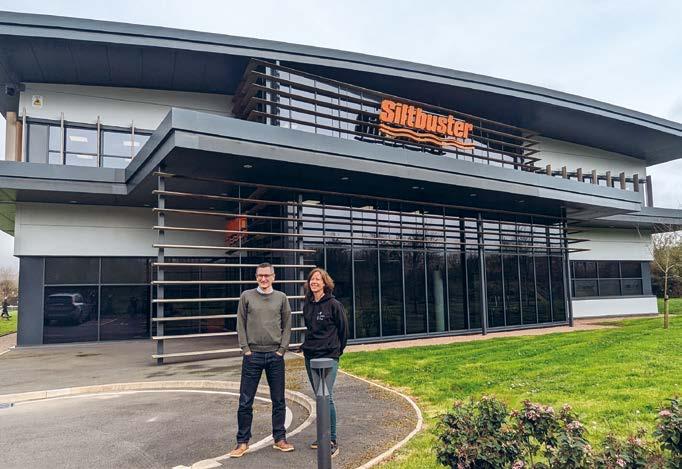
‘We are proud to now be partnering with the Gwent Wildlife Trust and committed to introducing biodiversity benefits for wildlife and people wherever possible.’
Surrounded by beautiful rolling hills, Siltbuster HQ is located just outside Monmouth. The bespoke-built facility was completed in 2017 with environmental measures already undertaken including photovoltaic roof panels to harness green solar energy to help power their operations and rainwater harvesting and water reuse. A man-made pond, created to manage water flow at the facility is already benefitting a diversity of birds and other wildlife. The British Dragonfly Society recently surveyed and recorded 5 different types of dragonfly present, including Black-tailed Skimmer and Large Red Damselfly.
Rich Matthews, Siltbuster Managing Director said: “We are committed to reducing the impact of our own business on the world around us, helping to secure a greener, brighter future for generations to come. We also work with clients, contractors and suppliers to support them in their own initiatives to minimise environmental harm and promote
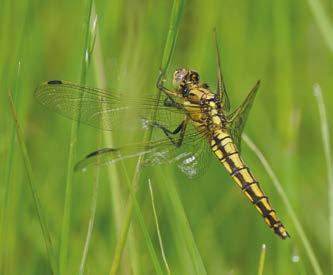
biodiversity and sustainability. We are proud to now be partnering with the Gwent Wildlife Trust and committed to introducing biodiversity benefits for wildlife and people wherever possible based on their recommendations. The
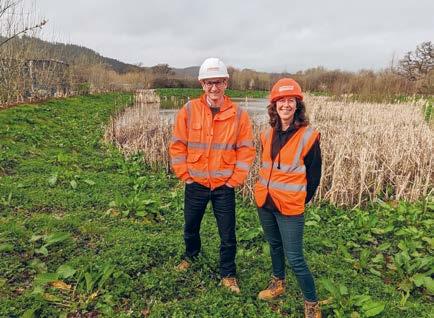
trust has an essential role to play in protecting the region’s wildlife and we are fully committed to supporting its work.”
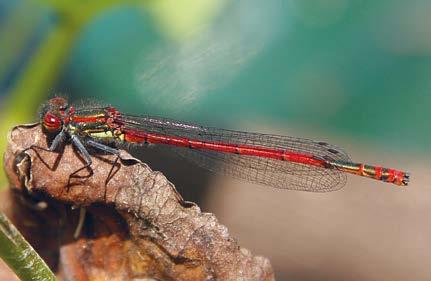
Beyond this, both organisations share a focus on the importance of water quality. Water is a precious resource that must be nurtured, handled with care and re-used whenever possible to the benefit of the environment. Minimising the risk of pollution events, Siltbuster protects the environment and watercourses around the areas where their clients work; treating contaminated water, removing and safely disposing of contaminants so that only clean water is discharged. While Gwent Wildlife Trust is focussing on improving water quality in Gwent rivers and their tributaries, by partnering with local landowners to implement natural solutions.

Evidence Manager Andy Karran goes into more detail on two of our ten species.
Having introduced the 10 vulnerable species, and over the last two issues thrown the spotlight on Grayling, Shrill Carder Bee, Pink Waxcap and Barn Owl, it is now the turn of two more. Both of these species have an air of mystery about them, and a healthy slice of folklore.
A fantastic bird of mystery, heard by relatively few, and seen by even less. It occupies the short dark hours of our summer, filling the air with its other-worldly song as the light slowly fades to darkness. It is little wonder there is so much folklore associated with this bird. Its alternative name of Goatsucker comes from the belief that it suckled milk from goats. In reality it was keeping close company of livestock and feeding on insects that were attracted to them. Its cavernous, whiskered mouth is perfectly adapted for this, hoovering up moths and the like. Nightjars also have folklore associations with death. The Norse
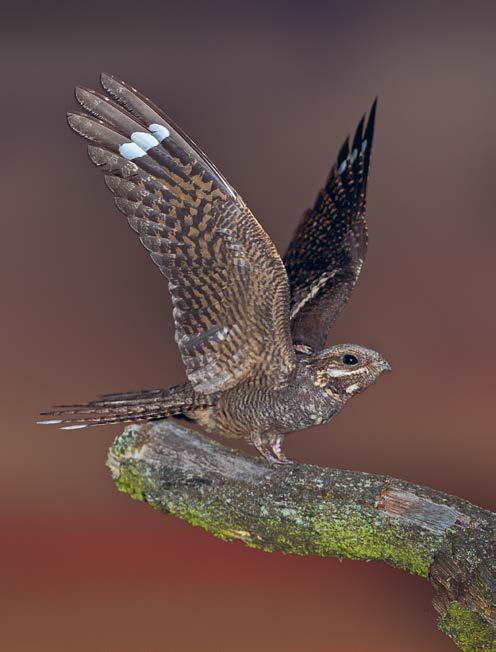
bracken covered hillsides and open woods, with felled and young plantation woodlands becoming important habitats more recently. They feed mainly at dawn and dusk on airborne insects, with moths and beetles making up a large part of the diet.
god Odin was accompanied by a “Night Raven” during the “Wild Hunt”, when ghostly fallen warriors would traverse the night sky and abduct unfortunates to transport off to the underworld. In olden-days Yorkshire it was believed that Nightjars were avian manifestations of the souls of unbaptised children, forever doomed to wander the night sky.
Let’s get back to reality! The Nightjar is a summer visitor to the UK but spends its winter in scrubby grasslands in Africa. Conservation of this species is complex, as vulnerabilities exist in their summer, winter and migration stepping-stone habitats and food sources, all of which may be impacted by climate change. In the UK, the Nightjar is primarily a bird of lowland heathland,
‘Both of these species have an air of mystery about them, and a healthy slice of folklore.’
In Gwent, their population and distribution has fluctuated greatly since they were first officially recorded here in 1926. Gwent’s Nightjars appear very much dependent on the availability of forestry plantation clear-fells or restocks at suitably open stages, with populations dwindling and shifting when suitable areas become more forested.
Nightjars in Gwent, and the wider UK still face several threats:
1. Large-scale loss of heathland to agriculture, construction and afforestation (particularly following the Second World War)
2. Afforestation of clear-fell sites
3. Disturbance for example by dogs and humans
4. Decline in prey availability, as a result of agricultural intensification
5. Climatic conditions - excessive cold and wet during breeding season
6. Issues on migration and wintering grounds
People have long held an interest in snakes, for some fear, for others fascination. The Adder is not to be feared, however and should be treated with respect. Here in Wales, druids who observed frenzied groups of Adders in spring, believed they formed a polished rock at the centre of their gatherings called a Glain Neidr (Adder Stone) which held supernatural powers.
The Adder is Britain’s only venomous reptile, a mechanism they use to immobilise their prey of lizards, small mammals and nestlings. They are highly secretive and well-camouflaged, making them particularly difficult to survey. Adders are found in open habitats, such as heathland, moorland and coastal areas. They are highly susceptible to local extinction in a changing landscape and rarely re-colonise suitable areas, without intervention. Adders mate in spring, incubate their eggs internally, and give birth to 6-20 live young in August or September. They hibernate during the colder months, from October to February, and re-emerge on the first warm days of March. An Amphibian and Reptile Groups of UK (ARG) survey in 2019 found the species could be extinct by 2032 if action isn’t taken.
I often hear stories of how Adders used to occur but haven’t been seen in years. This is a common tale across the UK.


Adders in Gwent, and the wider UK face several threats:
1. Persecution.
2. Loss and mis-management of habitats.
3. Small populations lead to inbreeding and loss of genetic diversity, which increases the risk of local extinctions.
4. Disturbance.
5. Climate change.
6. Predation by gamebirds, with pheasants highlighted as a particular impact.
Read our Action Plans for the Nightjar and Adder (and the other 8 species of 10) at gwentwildlife.org/wildlife/ten-vulnerablespecies-recovery), to discover our plans for restoration, what main actions need to be taken, along with key partners we will collaborate with.
Your help is of integral importance. One of our first actions is to establish where Nightjars and Adders are currently present, where they used to be, and also importantly are there any suitable areas where they are not currently present.
• Record - If you are out enjoying the Gwent countryside and see either of these species, please submit records to SEWBReC www.sewbrec.org.uk/ recording. Consider targeted visits to known or potentially suitable sites. Take part - join the Amphibian and Reptile Conservation’s “Connecting the Dragon’s” Project www.arc-trust.org/ connecting-the-dragons
• Send - please send any Nightjar sightings to the dedicated email address nightjar@gwentbirds.org.uk to help with planning for the 2025 census.
• Attend - A nightjar evening including an illustrated talk, introduction to the 2025 survey, and a walk to encounter the species. To be held jointly with the Gwent Ornithological Society in early June at the Cwmcarn Forest Drive Visitor Centre. A series of county-wide nightjar walks are also planned: 24th May, St James’ Forestry, Tredegar 31st May, Wentwood Forest, See GOS website for further details www.gwentbirds.org.uk/ 6th June, Beacon Hill www.gwentwildlife.org/events
• Nightjars are one of our last spring migrants to arrive, however most will be back with us by the time you are receiving this magazine. Between now and July is the time to listen out for them at dusk, with areas of heath and clearfell woodland the best sites to target.
• Adder emerge from hibernation in March and are likely to be active well into October. They favour areas of heathland, and may well share the same sites with Nightjars, however a visit during the day would have a far greater chance of success as Adders like to bask in the sun to warm-up.

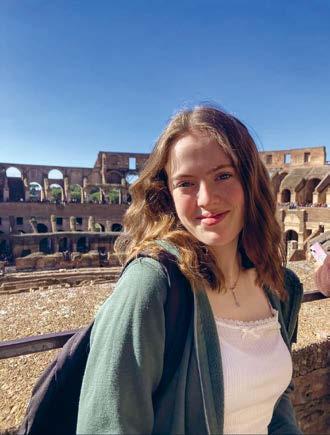
Lansiwyd prosiect Sefyll Dros Natur
Cymru yn 2021, gyda’r bwriad o rymuso pobl ifanc rhwng 9 a 24 oed i gymryd camau cadarnhaol yn eu cymuned i warchod bywyd gwyllt a brwydro yn erbyn effaith newid yn yr hinsawdd. Nawr, dair blynedd ers y dechrau, mae dau o aelodau hirsefydlog ein grŵp ieuenctid ni yng Ngwent yn adlewyrchu ar eu profiadau gyda’r prosiect a sut mae wedi rhoi hyder iddyn nhw gymryd camau cadarnhaol yn eu bywydau eu hunain.
Helo, fy enw i yw Abigail ac ar hyn o bryd ym mlwyddyn gyntaf fy nghwrs Safon Uwch yn astudio Celf, Daearyddiaeth a Ffotograffiaeth.
O oedran ifanc iawn rydw i bob amser wedi bod â diddordeb mewn bywyd gwyllt ac angerdd cryf iawn dros wneud fy ngorau glas i’w warchod ac i geisio addysgu pobl am bwysigrwydd aruthrol bywyd gwyllt a byd natur. Rydw i bob amser wedi cael fy nysgu i barchu, hoffi a mwynhau’r amgylchedd rydw i’n byw ynddo. Fe greodd fy nheulu a minnau ardd sy’n gyfeillgar i fywyd gwyllt a thrwy wneud hynny rydyn ni bellach yn croesawu llu o rywogaethau gwahanol. O ddraenogod, i lyffantod, adar, gwyfynod a glöynnod byw. Rydw i bob
amser yn teimlo mor hapus i weld beth mae pob tymor yn ei ddenu i’r ardd. Rydw i wrth fy modd yn gweld y gwahanol adar yn ymweld ac rydyn ni’n ddigon ffodus i fod â phoblogaeth enfawr o adar y to sy’n nythu’n hapus bob blwyddyn ym mondo’r to. Mae bob amser yn hynod ddiddorol gwrando ar eu clebran nhw a meddwl tybed am beth maen nhw’n ffraeo. Rydyn ni wedi gosod bocs i wenoliaid duon yn ei le yn ddiweddar ac rydw i’n gobeithio y byddwn ni’n ddigon breintiedig i gael pâr yn dewis nythu ar fy nhŷ i. Dydw i ddim yn dewis beth sy’n dod i mewn i’r ardd, rydw
i’n hapus i groesawu pawb, gan fy mod i’n gweld bod byd natur bob amser yn creu ei gydbwysedd ei hun.
Rydw i wedi gallu rhannu fy hoffter i o fywyd gwyllt, byd natur a’r amgylchedd drwy fy ngwaith celf. Ymunais â Chymdeithas Gelf 2 flynedd yn ôl ac rydw i wedi arddangos fy ngwaith celf yn adeilad y Pier Head yng Nghaerdydd, yn ogystal â fy amgueddfa leol. Rydw i wedi bod wrth fy modd yn creu portread o un o fy arwyr natur i, Iolo Williams, ac roeddwn i’n ddigon ffodus i’w gyfarfod e yn ddiweddar. Fy hoff baentiad i yw un o’r ardal lle rydw i wedi bod ar fy ngwyliau am y ddwy flynedd ddiwethaf. Mae’r lle yma’n bwysig iawn i mi gan fod y perchnogion wedi dod i reoli tir fferm a bellach wedi ei ailwylltio i fod yn warchodfa natur hardd a thawel. Rydw i bob amser yn cael fy syfrdanu gan harddwch pur y lle a sut mae byd natur bob amser yn adfer, er gwaetha’r hyn sydd wedi digwydd o’r blaen.
Darllenwch erthygl lawn Abigail ar-lein: www.gwentwildlife.org/StandForNatureWales Rhyfelwr Bywyd Gwyllt Aidan
Rydw i’n credu bod cyfle ym mhob cymuned i helpu’r amgylchedd a byd natur yn ei gyfanrwydd.
Meddai Aidan, aelod o Sefyll Dros Natur Cymru a Rhyfelwr Bywyd Gwyllt
Helo, Aidan ydw i ac fe wnes i ymuno â phrosiect SDNC ym mis Mai 2023 a gallaf ddweud yn falch ei fod yn un o’r penderfyniadau gorau rydw i wedi’i wneud o ran fy nyhead i helpu’r amgylchedd mewn unrhyw ffordd y gallaf yn fy mywyd personol. Roeddwn i wedi bod yn chwilio am grŵp natur ac roeddwn i’n ddigon ffodus i gael fy nghyfeirio at gyfle anhygoel ym Magwyr. Fe wnes i ymuno hefyd
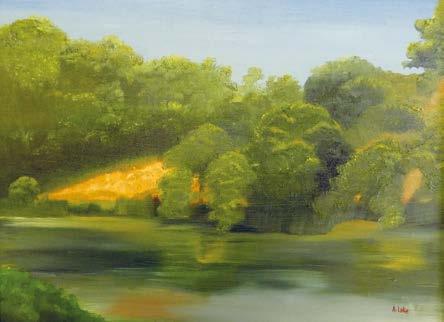

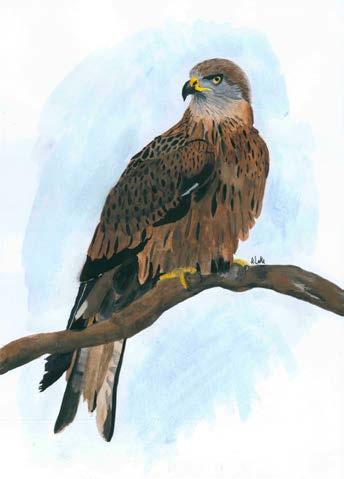
oherwydd mai rôl mewn cadwraeth fyddai fy ngyrfa ddymunol i ac roeddwn i hefyd eisiau dod o hyd i ffordd i droi fy mhryder eco eithaf mawr yn gamau gweithredu cadarnhaol a newid. Yn bersonol, fe fyddwn i’n dweud mai dyna un o’r pethau hyfryd am fod yn aelod o grŵp SDNC oherwydd mae’n fy atgoffa i o’r gobaith sy’n dal i fodoli am achub yr amgylchedd, er gwaetha’r holl newyddion hinsawdd sy’n achosi cryn bryder.
Yn y grŵp rydw i wedi dysgu llawer am wahanol rywogaethau, a gwahanol ddulliau cadwraeth a monitro, sydd wedi golygu fy mod i wedi gallu helpu YNG gydag arolygon fel diwrnod hyfforddi arolygu Llygod yr Ŷd ym mis Chwefror, ac fe wnes i fwynhau yn fawr. Yn ffodus, fe gadwodd y glaw draw nes i ni orffen ein harolygu ac fe wnes i lwyddo i restru llawer o’r llygod welsom ni fel grŵp gan ddefnyddio’r ap Mammal Mappers gan y Gymdeithas Mamaliaid ac rydw i wedi cyflwyno hwn. Yn bersonol, fe ddois i o hyd i safle bwydo llygod pengrwn y dŵr, nyth llygod pengrwn y maes ac un o’r 5 o nythod llygod yr ŷd ddaethon ni o hyd iddyn nhw, ac rydw i’n hynod falch o hynny gan fy mod i’n hapus iawn bod llygod yr ŷd yn parhau i fod yn bresennol yng Nghors Magwyr ar ôl y cofnod diwethaf oedd gan YNG o lygod yr ŷd yn y warchodfa o 2014. Rydw i’n gobeithio gwirfoddoli a chymryd rhan mewn llawer mwy o weithgareddau fel yr un yma yn y dyfodol i helpu i feithrin fy sgiliau ymarferol ac, yn fwy na dim, helpu YNG gyda’i gwaith rhyfeddol o glodwiw i warchod yr holl rywogaethau gwerthfawr y mae’n bleser cael eu cwmni nhw ar Wastadeddau Gwent.
Parhewch i ddarllen erthygl Aidan ar-lein: www.gwentwildlife.org/StandForNatureWales
The Stand for Nature Wales project was launched in 2021, with a view to empower young people aged between 9 and 24 to take positive action in their community to protect wildlife and combat the impact of climate change. Now, three years since the start, two of our long-standing Gwent youth group members reflect on their experiences with the project and how it has given them confidence to take positive steps in their own lives.
Hello, my name is Abigail and I am currently in my first year of A-Levels where I am studying Art, Geography and Photography.
From a very young age I have always had an interest in wildlife and a very strong passion to do my upmost to protect and to try and educate people about the sheer importance of wildlife and nature. I have always been taught to respect, love and enjoy the environment in which I live. My family and I created a wildlife friendly garden and in doing so we now welcome a
host of different species. From hedgehogs, to toads, birds, moths and butterflies. I always feel so happy to see what each season brings into the garden. I love to see the different birds visiting and we are lucky enough to have a huge colony of sparrows who happily nest every year in our roof eaves. It is always fascinating to listen to their chatter and wonder what they are squabbling about. We have recently installed a swift box and I am hoping that we will be privileged enough that a pair will choose to nest on my house. I don’t pick and choose what enters the garden, I am happy to welcome all, as I find nature always balances out.
I have been able to share my love of wildlife, nature and the environment through my artwork. I joined an Art Society 2 years ago and have displayed my artwork in the Pier Head building in Cardiff, as well as my local museum. I have loved drawing a portrait of one of my nature heroes Iolo Williams, who I was lucky enough to meet recently. My favourite painting is of the area where I have holidayed for the last past two years.
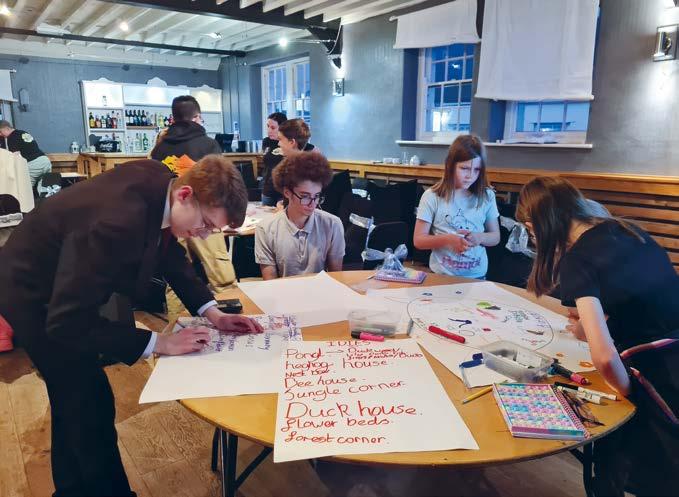
This place is very important to me as the owners have taken over farmland and have now rewilded it back to a beautiful and tranquil nature reserve. I am always in awe of the sheer beauty of the place and how nature will always recover, despite what has gone on before.
Read Abigail’s full article online: www. gwentwildlife.org/StandForNatureWales
“I believe that there is an opportunity in every community to help the environment and nature as a whole.” Says Wildlife Warrior, Stand for Nature Wales member, Aidan.
Hello, I’m Aidan and I joined the SFNW project in May 2023 and I can proudly say that it’s one of the best decisions I’ve made towards my desire to help the environment in any way that I can in my personal life. I had been looking for a nature group and I was lucky enough to be pointed in the direction of an amazing opportunity in Magor. I also joined because my desired career would be a role in conservation and I also wanted to find some way to turn my fairly large amount of eco-anxiety into
positive action and change. Personally, I’d say that’s one of the beautiful things about being a member of the SFNW group because it does remind me of the hope that still exists to save the environment despite the large amount of anxiety-inducing climate news out there.
In the group I have learnt a lot about different species, different methods of conservation and monitoring, which has meant that I have been able to actively help out GWT with surveys such the Harvest mouse survey training day in February, which I greatly enjoyed. Luckily, the rain stayed away until we had finished our surveying and I managed to list lots of sightings we made as a group using the Mammal Mappers app by the Mammal Society and I have submitted this. I personally found a water vole feeding site, a field vole nest and one of the 5 Harvest mouse nests that we found, which I am immensely proud of as I’m very happy that Harvest mice are still present at Magor Marsh after the last recording GWT had of harvest mice on the reserve was from 2014. I hope to volunteer and take part in many more activities just like this in the future to
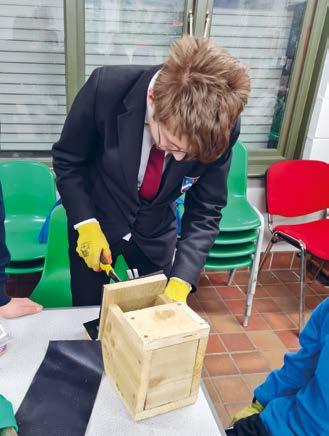
help build up my practical skills and most of all, help GWT in their amazingly admirable work to conserve all the precious species we are blessed with on the Gwent Levels.
Continue reading Aidan’s article online: www.gwentwildlife.org/StandForNatureWales

As a child, I remember on summer evenings watching and being captivated by swifts. They seemed to defy gravity with lightning aerial displays, followed by screams of rejoice to reinforce the fact. Ever since, I have been obsessed with the common swift, eagerly awaiting their return to herald the summer. Growing up, I have witnessed a year-on-year decline in the number of birds that return. Tragically, the resident swifts I remember in my home village are no longer there and the summer sky there is now silent.


When I moved to Usk several years ago, I was so happy to see and hear swifts in the summer skies! I set about finding if there was anyone in Usk keeping an eye on them. I contacted Gwent Ornithological Society (GOS) and discovered there had been a nest count carried out in Usk in 2014 but no official subsequent studies had followed thereafter. This news prompted me to put steps in place to help raise awareness about these fascinating birds, as, although there was evidence of swifts breeding in Usk, I had no doubt that following the national trend, the local swifts were probably in decline.
The initial step taken was community engagement. I knew I had to make local people aware of swifts and their plight. Without community support, all endeavours would be futile. GOS and I decided a good way to get people involved would be to host guided walks. The walks were received very positively, and consequently, the community’s interest in ways to help swifts soon began to gain momentum. It was at this point I realised I would need help if plans were to move forward successfully. I approached a handful of enthusiastic people willing to help. Thus, Swifts of Usk was born, and we are now a team of six.

The project has been a continuous learning process. As a result, we are constantly adapting. Thankfully, each team member possesses skills that complement the vision and goals we hope to achieve. We ran a series of swift nest box workshops in Usk in 2022 and 2023.
We’re pleased to say there are now about 40 swift nest boxes in Usk and the local area.
The very unsettled weather of summer 2023 made it a difficult summer for our swifts, severely affecting breeding and nest prospecting behaviour. We did receive reports of swifts taking interest in some of the boxes and we hope those boxes are entered by pioneering birds this year.
We have been active in providing educational presentations given to a number of local groups and organisations and that work will continue. We aim to provide information and support for anyone wishing to purchase swift boxes and advice on providing a suitable home for swifts. We will be leading two guided walks in 2024, one in June and the other in July. In addition, any swift spotting carried out by members of the team on weekday evenings will be posted in advance to allow anyone wishing to see our swifts to join us. Our ambitious project this year will be providing a potential home for a colony of swifts in the tower of a local church.

Swift Action Diary Markers: Join Swifts of Usk group for (two) one hour tours to help count swifts on June 13, and July 19, meet at 8pm at Maryport Street car park. Find more details on Facebook Swifts of Usk group or visit: gwentbirds.org.uk, or email Swiftsofusk@gmail.com

I was born in a small village just outside Crosskeys in the Sirhowy valley, and have always been fascinated with wildlife and nature. I’m now a firefighter with South Wales Fire and Rescue. I’m married to my wife Nyree and we share our home with our three bearded collies and are very active with the bearded collie club of Great Britain of which I am a committee member. I have an HND in animal studies through the University of Glamorgan. I am an ambassador for swifts and the advisor for them with the Gwent Ornithological Society (GOS).
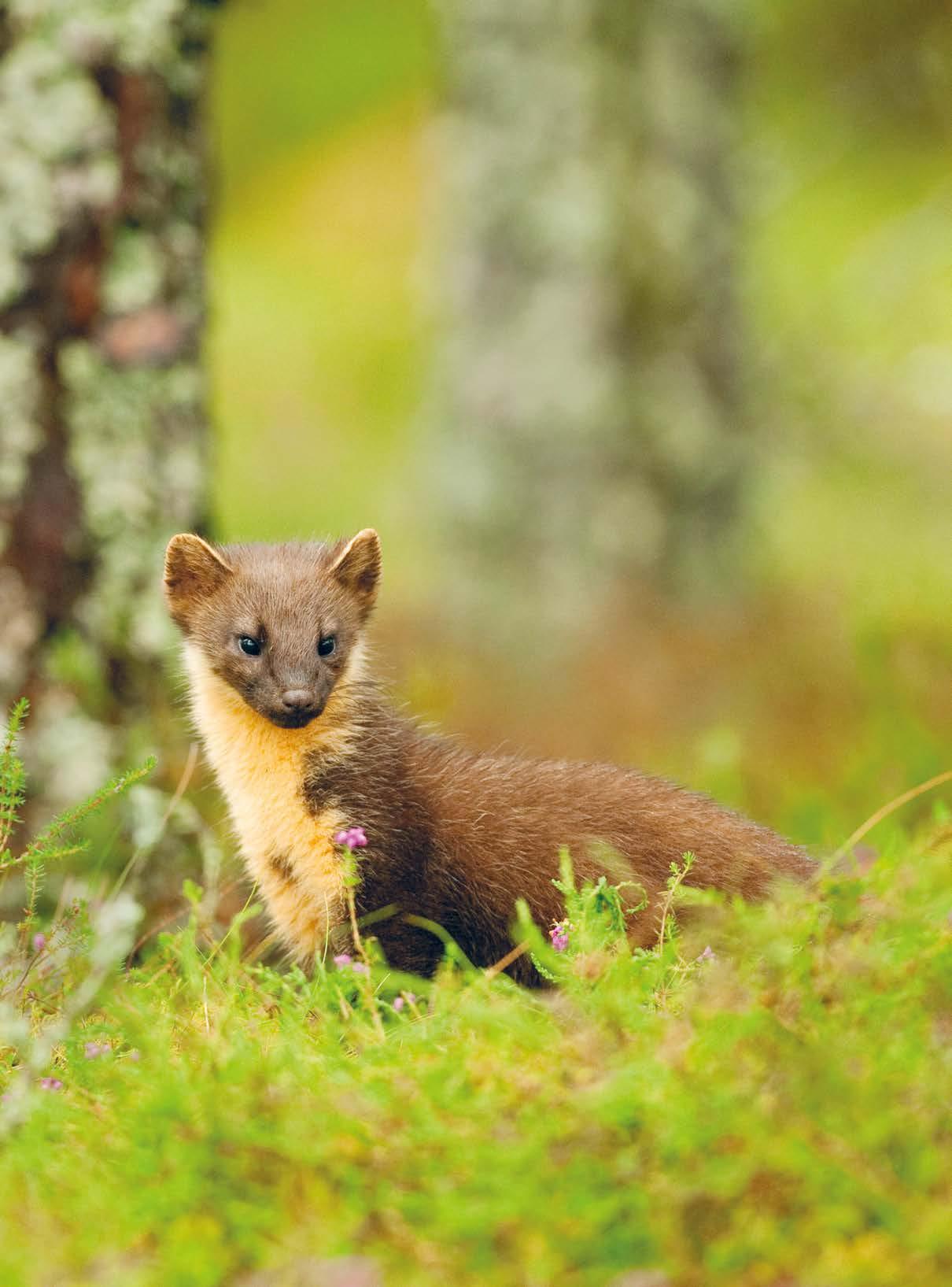
With GWT’s Community Ecologist Kath Beasley
Pine martens are a conservation icon, with multiple successful reintroduction stories from across the UK and populations popping up in places they were thought to have been lost. Here in Gwent, we are benefiting from reintroduction projects that took place in Gloucestershire back in 2019-2021 by Gloucestershire Wildlife Trust, Forestry England, Forest Research, Vincent Wildlife Trust and partners, who successfully released 35 pine martens into the Forest of Dean and lower Wye Valley.
Thanks to past and recent monitoring efforts by ourselves, Gloucestershire Wildlife Trust and Natural Resources Wales, we can confidently confirm that pine martens have crossed the border and are recolonising their historic range in Gwent. Now that we know they are here in the east of the county, we are focusing our efforts on trying to answer the question: How far have they spread across Gwent?
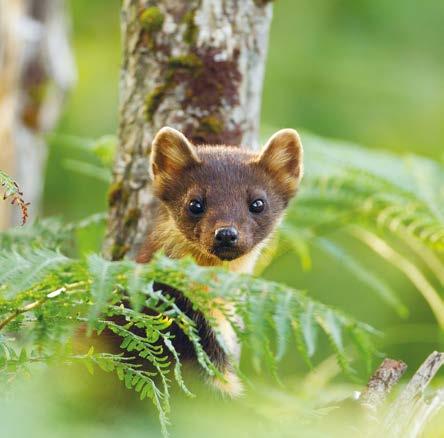
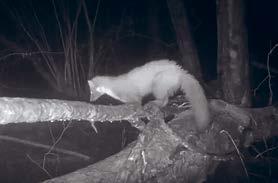
By looking at their range within the county, we can interpret what habitats they are using, how good the connectivity is and if there are regions we can target for future work to support their recovery.
Previous monitoring efforts have been in targeted areas in which pine marten were thought to occur. Although this is great for confirming their presence, a more systematic methodology covering a wider area of Gwent was needed to provide a better understanding of how and where the pine martens are occurring in the county.
Since the summer of 2023, we have been working hard to establish a more thorough monitoring system. Working with Gloucestershire Wildlife Trust has allowed us to learn from their considerable knowledge base and survey experience, thus ensuring consistency in survey methodology.
We have devised a grid system, splitting Gwent into 2x2 km squares and all suitable habitat identified via satellite imagery. With the help of volunteers and landowners, we are now working to set up a camera trap in each grid, rotating them around all the identified grids. A camera is in place for just 6 weeks and is baited with tasty treats such as sardines, peanut butter and eggs that are irresistible to a passing pine marten. If
“It is hoped that pine martens will play an important role in suppressing grey squirrel populations”
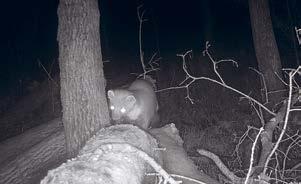
there is a pine marten in the area, it will pick up the scent of the bait and be sure to pay our camera a visit!
So far, we have had a 30% success rate on our cameras, picking up pine martens on 1/3 of the cameras we have put out, including one on one of Gwent Wildlife Trusts’ reserves, which we are very excited about! (We can’t disclose the exact location due to the sensitive nature of this species which is protected under the Wildlife and Countryside Act 1981 (as amended).)
When the pine marten oblige, we get clear chest shots of the individuals. Each pine marten has a unique bib pattern, allowing us to create a database of individuals, helping us understand individual movement across Gwent. We have already had one well-travelled individual popping up on multiple cameras!
We will continue to put up cameras in different locations, working closely with landowners and volunteers to build a better understanding of this iconic species to help ensure its protection.
Pine martens play an extremely important role in maintaining a healthy, balanced ecosystem. As a meso-predator (a medium sized predator that is in the middle of the food chain), they do this in multiple ways. As a generalist feeder, pine martens eat a wide range of food from small mammals, birds and eggs to fruits and fungus. They eat opportunistically, meaning they will eat whatever food source is bountiful at the time. This is particularly important, as by foraging the most abundant species, pine martens suppress its population, allowing other rarer species to thrive. This process means that no one species becomes dominant, enhancing the ecosystem’s biodiversity.
Pine martens have gained popularity due to their interaction with grey squirrels. As a non-native species, grey squirrels are the key driver behind the decline of our native red squirrels, as well as causing considerable damage to woodlands, stunting forest regeneration. While red squirrels have co-existed with pine martens for centuries in Britain, grey squirrels haven’t evolved mechanisms to evade this arboreal predator. Although pine martens can predate both squirrel species, studies in Scotland have shown that the presence of pine martens naturally controls grey squirrel populations, allowing red squirrel populations to recover in these areas. More research is needed to understand interactions elsewhere in the country, but it is hoped that pine martens will play an important role in suppressing grey squirrel populations, leading to recovery for both our native red squirrels and woodland habitats.
This project is being supported by the Nature Networks Fund, and National Lottery Heritage Fund with support from the Wye Valley AONB at the beginning of the project.
In March, we held our annual Local Wildlife Site Landowners’ Day, thankfully in person, after a few years online. This is a day when the owners and managers of the network of some 500 privately-owned wildlife havens can get together, learn from the speakers and each other and reinforce the community of these vital sites. Local Wildlife Sites provide refuges for wildlife and ensure vital connectivity across the landscape, and total a far greater hectarage than all our Nature Reserves put together. The management is undertaken by the owners with some survey and management advice provided by GWT if required.

During the day we had a fantastic series of talks from Dylan Allman of Hedgehog Action, Verity Picken



This Summer, Gwent schools will have the opportunity to take part in an exciting programme offered by Durrell Wildlife Conservation Trust. Gwent Wildlife Trust and Durrell have been working together on projects to
from Gwent Ornithological Society on Curlews, as well as two talks from Gwent Wildlife Trust’s Nathalie Nicolaus and Joe Ryder on Nature Based Solutions in waterbodies, and Conservation Grazing respectively. Hopefully, everybody left feeling more informed and enthused to take action for wildlife on their land and beyond.
“Local Wildlife Sites are technically a tier below the Statutory Protected SSSI’s, but in many cases are actually equally or more valuable ecologically. They are a way of recognising some of the best places for wildlife locally. They are areas considered to be of particular conservation value because of the habitats or species they support. Local Wildlife Sites play a crucial role by providing wildlife refuges, protecting threatened species and habitats, and acting as links and corridors between other valuable sites.”






secure Wales’ biodiversity and pave the way for species regeneration in Gwent. Schools 4 Species is a programme that includes educational workshops, field trips, and art sessions focusing on native Welsh species, including the White-tailed Eagle. Stage one involves outdoor and classroom learning, while stage two features an art competition. Stage three will host a day event at Gilwern Outdoor Education Centre for secondary school

representatives to discuss how to support species in Wales.
Our programme aims to raise the profile of Wales’ missing and threatened species while offering activities to enhance the wellbeing and nature connection of young people. We hope to inspire a generation of wildlife lovers and empower students to stand for nature.
For more information on the Schools 4 Species programme and how you and your school can get involved, please contact Krystal King – krystal.king@durrell.org

Twenty five years ago, Ian Rabjohns and his late wife Jessica moved to the smallholding known as Mill Bank in Penallt and soon became aware of what an intricate invertebrate network their land supports. By matching the researched management of the site as closely as possible over the years, the network has been preserved, monitored, and now documented.
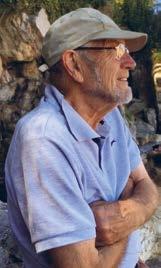
Name: Ian Rabjohns
Lives in: Penallt
Job: Retired from teaching outdoor education and bat consultant.
Interesting fact: First known study of invertebrates was collecting ladybirds in a jam jar at age four.
Tell us about yourself in 30 words. Trained at Loughborough, I worked in outdoor education in Staffordshire and the Black Mountains, with a two year ‘escape’ teaching in Northern Alberta. I always hankered for my own bit of wildness.
What’s your favourite local place for nature?
I have two. One is the upper Olchon Valley, an un-spoilt steep sided valley where I used to love watching ring ousels and teaching young people how to interpret the landscape, geology and its mountain flora. I am now biased towards my own little piece of heaven as I have found that it has so much to offer, and of course the benefit that

Above, Buzzard just outside my bedroom window ant bathing a.k.a ‘passive anting’ on one of the numerous anthills. Right, a gravid Rugged oil beetle eating buttercup leaves in the garden to top up its toxic ‘oil’, commonly known as Ranunculin.
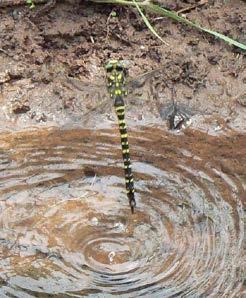
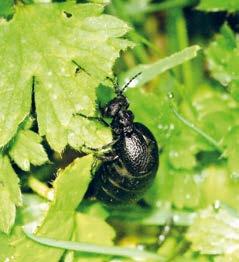
so much can be seen and found here so close to the house and the garden bench! Although the wider county has so much to offer, I have in retirement concentrated on getting to know my small patch in detail. When and where to look out for the ‘regulars’ and to delight in the new arrivals.
Tell us a memorable wildlife experience you have had locally/in the UK. When I was heavily involved with bat conservation as a licenced bat worker and trainer; I spent a great deal of time expanding knowledge of the lesser horseshoe bat in Gwent, discovering many new roosts. When investigating a tiny crevice in a landslip area it was very rewarding to find a major hibernation site for the species. Over forty animals, including an albino, were hanging on a single roof. I was able to continue a long-term study of this site with the help of equipment from the Countryside Council for Wales and wrote up a paper for them.
Why should people care about the climate crisis and nature emergency? To be very blunt if they do not care, and do not do the little that everyone can do; then their grandchildren and the following generations will suffer increasing hardship with supplies of food, clean water and living space. The natural world was the regulator of our planet’s resources, until humans upset the balance.
Who has inspired you:
It was always of concern that so many were getting their wildlife knowledge from television films of the weird and wonderful
when they had no idea what was in their own gardens. David Bellamy’s “Backyard safari” was a great step in trying to rectify this and still has enormous relevance today.
Name one thing everyone should do to make a difference for the sake of nature and our planet?
Be satisfied with having less and travelling less. It would be better to downsize your consumption now than leave nothing for future generations. If you can influence even a small piece of ground. It is often not what to do but what not to do. Let your garden go ‘jungley’. Don’t be tidy out there. At the time of writing this I am not mowing the grass around the house so that the three dozen or more bee species that I know of here have a lovely display of dandelions as a food resource.
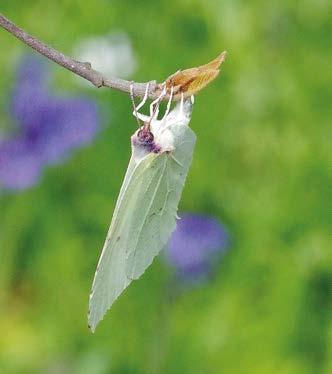
Discover hidden gems on our nature reserves and learn new skills whilst immersed in some of the most amazing wildlife in Wales! We’d particularly encourage those who haven’t been to one of our events before to join us this year, it’s the perfect opportunity to learn more about your local wildlife and how to help nature’s recovery.
What we have planned in 2024 so far!
21 May Dawn Chorus at Magor Marsh
4 Jun Meadow Plant Identification for Beginners, Pentwyn Farm
6 Jun Nightjars at Beacon Hill
11 Jun Meadow Plant Identification for Intermediates, Pentwyn Farm
14 Jun Woodland Wellbeing - Bushcraft Taster, Magor Marsh
18 Jun Springdale Farm – Meadow Stroll
21 Jun The River Wye from Dixton to Dixton Embankment
8 Jul Nature Walk for Wellbeing, Magor Marsh
11 Jul Magor After Dark
25 Sep Annual General Meeting
Spaces for our events go quickly so we advise booking now! Make sure to check back regularly as well as read our eNewsletter as there will be more events added throughout spring and summer.
Book
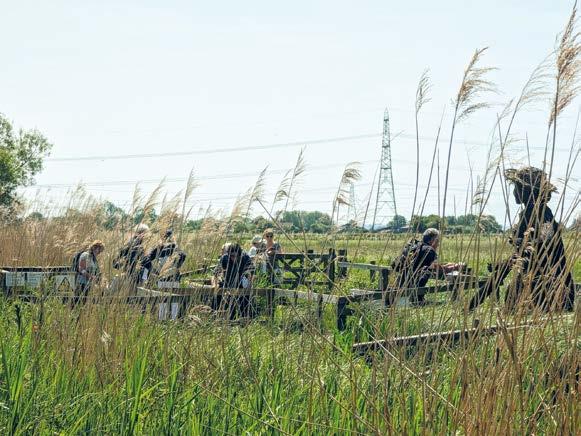
Also, here are some of the events we’ll be at - come and say hello!
1 Jun Usk River Festival
13 Jun Save Usk’s Swifts - Swift Count
29 Jun Pontypool Go Wild!
15 Jul Schools 4 Species Gwent Conference, Gilwern
19 Jul Save Usk’s Swifts - Swift Count
10 Aug Chepstow Show
18 Aug Monmouth Show
14 Sep Usk Show
20 Oct Greener Abergavenny
30 Jun - 1 Jul Monmouth Haberdasher’s Local to Global Conference
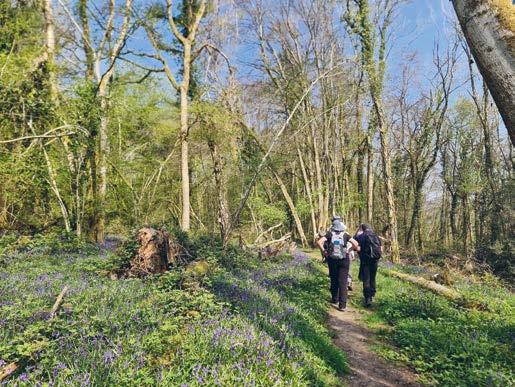
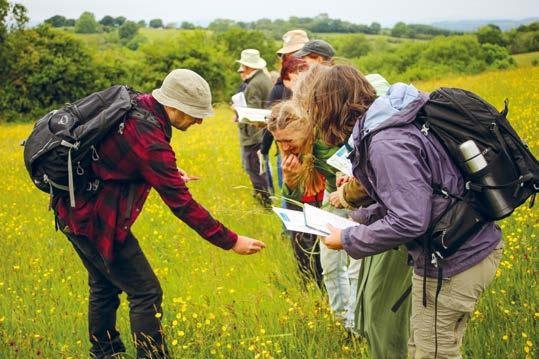 PHOTO CREDITS: HAMISH BLAIR, EMILY MACAULAY
PHOTO CREDITS: HAMISH BLAIR, EMILY MACAULAY